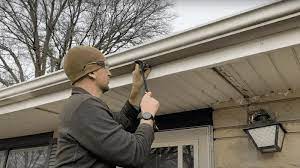Aluminum fascia is a crucial component of a building's exterior, serving both functional and aesthetic purposes. It is the finishing edge that runs along the roofline, covering and protecting the exposed ends of the rafters and providing a smooth, clean appearance to the structure. Over time, however, aluminum fascia may experience wear and tear due to various factors such as weather exposure, corrosion, or physical damage. When this occurs, timely and effective repair becomes essential to maintain the integrity of the building and enhance its curb appeal.
Understanding the Importance of Aluminum Fascia Repair
Aluminum fascia repair is not merely a cosmetic consideration; it plays a vital role in preserving the structural integrity of a building. The fascia serves as a barrier, preventing water from infiltrating the roofing system and protecting the underlying wood or other materials from moisture damage. When compromised, it can lead to a cascade of issues, including rot, mold growth, and even structural damage.
Moreover, damaged or deteriorating aluminum fascia can significantly impact the visual appeal of a building. As a prominent exterior element, the fascia contributes to the overall aesthetics, and its condition can influence the perception of the property. Timely repair not only addresses functional concerns but also contributes to the property's overall maintenance and value.
Signs of Aluminum Fascia Damage
Before delving into the repair process, it is essential to identify the signs of aluminum fascia damage. Some common indicators include:
- Corrosion: Aluminum is resistant to rust, but it can still corrode over time, especially in areas with harsh weather conditions or high humidity. Corrosion often manifests as pitting, discoloration, or a rough texture on the surface.
- Dents and Dings: Physical damage from impacts, such as hail or falling debris, can result in dents and dings on the fascia. These not only compromise the appearance but may also weaken the material.
- Peeling or Chipping Paint: The paint on aluminum fascia repair serves both decorative and protective purposes. Peeling or chipping paint indicates a need for attention, as it exposes the metal to the elements, potentially accelerating deterioration.
- Loose or Detached Sections: Harsh winds, storms, or improper installation may cause sections of the aluminum fascia to become loose or detached. This compromises its ability to provide effective protection and requires prompt repair.
Steps for Aluminum Fascia Repair
- Assessment of Damage: Before initiating repairs, a thorough assessment of the extent of the damage is crucial. This involves inspecting the entire length of the fascia, identifying areas of concern, and determining whether repair or replacement is necessary.
- Cleaning and Preparation: Cleaning the damaged area is essential to ensure proper adhesion of repair materials. Use a mild detergent or aluminum-friendly cleaner to remove dirt, grime, and any loose paint. Sanding the damaged area lightly can help create a smooth surface for repairs.
- Corrosion Treatment: If corrosion is present, it must be addressed before proceeding with repairs. Remove the corroded areas using a wire brush or sandpaper, and treat the surface with a corrosion-resistant primer to prevent further degradation.
- Filling and Patching: For small dents or scratches, an aluminum patching compound or filler can be applied. This material should be specifically designed for outdoor use and compatible with aluminum. Follow the manufacturer's instructions for application and drying times.
- Replacement of Damaged Sections: In cases where the damage is extensive or the integrity of the fascia is compromised, it may be necessary to replace entire sections. Carefully remove the damaged portions, ensuring that the replacement pieces match the existing profile and color.
- Priming and Painting: Once the repairs are complete, it's crucial to prime and paint the aluminum fascia to provide a protective barrier against the elements. Choose high-quality exterior-grade primer and paint that adhere well to aluminum surfaces.
- Sealing Joints and Gaps: Pay attention to joints and gaps between the fascia and other building elements. Applying a flexible exterior caulk can help seal these areas, preventing water infiltration and enhancing the overall weather resistance of the fascia.
- Regular Maintenance: To extend the life of the repaired aluminum fascia, incorporate regular maintenance into your building care routine. Periodically inspect the fascia for signs of wear, address any emerging issues promptly, and touch up paint as needed.
DIY vs. Professional Repair
The decision to tackle aluminum fascia repair as a do-it-yourself (DIY) project or enlist professional assistance depends on the extent of the damage, the individual's skill level, and the tools and materials available. While minor cosmetic repairs such as patching small dents may be manageable for DIY enthusiasts, extensive damage or structural issues may require the expertise of a professional contractor.
Professionals bring not only the necessary skills but also the experience to accurately assess the condition of the aluminum fascia and recommend appropriate repair strategies. Additionally, they have access to specialized tools and materials that may not be readily available to homeowners.
Conclusion
Aluminum fascia repair is a crucial aspect of maintaining a building's structural integrity and aesthetic appeal. Regular inspection and timely repairs can prevent more significant issues, such as water damage and rot, and contribute to the overall longevity of the structure. Whether undertaken as a DIY project or entrusted to professionals, aluminum fascia repair requires careful assessment, proper preparation, and the use of suitable materials to ensure a durable and visually appealing result. By addressing issues promptly and incorporating regular maintenance practices, property owners can safeguard their investment and enjoy a well-maintained and visually pleasing exterior for years to come. Visit official website onlyroofing.com

